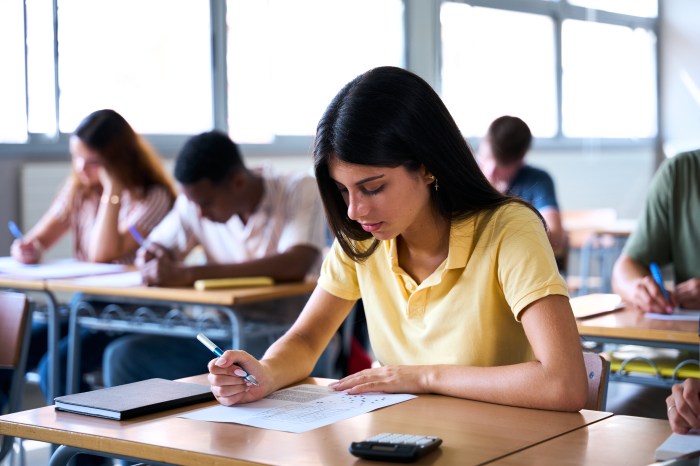Locust Valley school officials reviewed elementary enhancements for the 2025-2026 school year, anticipating expanding pre-K from 36 to 54 students. Officials also looked at the proposed $98.2 million budget for the coming year, expecting a 2.3% increase in the tax levy.
To kick off the Wednesday, March 26, Board of Education meeting, the district celebrated its Model United Nations team.
“Our program has grown significantly,” said Katie Kuebler, senior and secretary general of the club.
She said that in previous years, the club received one or two awards per season, but this year, the team has been receiving at least one award at each competition it attends. Last weekend the club attended a conference at Schreiber High School in Port Washington, receiving five awards: two best delegate awards, two honorable mentions and one outstanding delegate award, she said.
“Best delegate is the highest level of accomplishment you can achieve,” Kuebler said.
Board President Lauren Themis said district officials, staff members and community members are proud of the students’ work and support the club’s advancements.
“Your future is bright,” she said.
Officials looked at enhancements expected in its elementary curriculum, based on an envisioned expansion of almost 20 students in its pre-kindergarten programming.
“It’s important to note that our pre-K program is New York State grant-funded,” said Janine Sampino, assistant superintendent for curriculum and instruction.
Sampino said the district receives $5,400 per student and plans on expanding the program’s enrollment from 36 students to 54 in the coming year.
Sampino said the school plans on adding a dedicated science teacher in grades three through five, which has been anticipated by many in the district.
“The students felt a need for it, we felt a need for it, the teachers felt a need for it,” she said. She said there is a new science exam and standards from the state, which are “becoming more rigorous.”
Sampino said the district will also enrich its curriculum as a whole to ensure students can bridge connections between lessons.
“The more connections students make, the deeper meaning they get,” she said.
Sampino said that since the 2021-2022 school year, the district’s elementary schools have been reduced by seven classes.
In the 2021-2022 school year, Bayville Intermediate had 11 sections, Bayville Primary had nine, Locust Valley Intermediate had 11 and Ann McArthur Primary had 11, she said.
Looking ahead at the 2025-2026 school year, it is expected that Bayville Intermediate will have eight classes, Bayville Primary will have seven, Locust Valley Intermediate will have 10 and Ann McArthur Primary will have 10, she said.
Sampino said that within the buildings, changes have not been felt because there have been teacher retirements and staff shifts. She said some staff members who had been teaching general education moved to special education classrooms in the past few years.
The reduction in classrooms does not account for shared classrooms, such as music, art, physical education and library specials.
Superintendent Kristen Turnow said the decrease in Locust Valley’s enrollment is part of a county trend.
“From 2019 to 2024, there’s been 61% of Nassau County school districts that have had significant decreasing enrollment,” she said.
Turnow said Locust Valley’s enrollment is down 8.4% since 2019. In the 2019-2020 school year, the district had 2,012 students enrolled. In the 2025-2026 school year, it is estimated that the district will have 1,789 students, with projected decreases in the following years.
Turnow said that with declining enrollment, the district encourages its teachers to have multiple certifications, such as special education. Extending certifications makes teachers “more flexible,” she said.
The district proposed a $98.2 million budget for the 2025-2026 school year, an approximate $1.8 million increase from the previous year, said Assistant Superintendent for Business Karen Horoszewski. She said there are expected increases in transportation costs and staff benefits, such as insurance and worker’s compensation, in the upcoming school year.
“The budget is a work in progress,” she said. “Updates are being made,” and the district’s revenue is subject to change as state aid is finalized.
For the upcoming budget, Horoszewski said the maximum tax levy increase is 2.7%, approximately a $2.3 million increase totaling a $90.4 million levy.
The district expects to remain below the maximum with a 2.3% increase, totaling approximately $90.1 million.
The 2024-2025 budget was $96.4 million, with an approximate $88 million tax levy accounting for over 91% of the district’s revenues.
As of the 2024-2025 district enrollment data, calculated by the state in October, the district comprises 1,794 students. If the proposed $98.2 million budget is approved, the district will spend approximately $54,772 per pupil based on enrollment remaining steady.
The budget adoption will be April 22, the budget hearing will be held on May 7 and the budget vote will be on May 20.
































